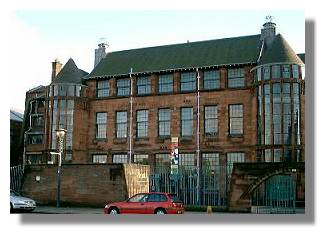
Introduction
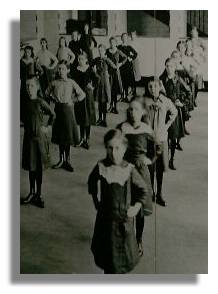 Charles Rennie Mackintosh, one of Scotland's best known architects and designers, was responsible for two schools during his career. Martyr's Public School in Glasgow was built in 1895 when Mackintosh was an assistant in the firm of Honeyman and Keppie. In 1903, Mackintosh received the commission for Scotland Street Primary School. Initially it was an infants school but latterly became a Primary School (for ages 5 to 12). But it took until 1906 before it was completed. Part of the reason for the delay was the running battle between Mackintosh (who wanted to introduce his design elements) and the school board (who wanted a standard school board product, within budget). While Mackintosh won some of the arguments (as can be clearly seen in finished building), he lost others. And the project was 25% over budget, which no doubt did not please the parsimonious Board!
Charles Rennie Mackintosh, one of Scotland's best known architects and designers, was responsible for two schools during his career. Martyr's Public School in Glasgow was built in 1895 when Mackintosh was an assistant in the firm of Honeyman and Keppie. In 1903, Mackintosh received the commission for Scotland Street Primary School. Initially it was an infants school but latterly became a Primary School (for ages 5 to 12). But it took until 1906 before it was completed. Part of the reason for the delay was the running battle between Mackintosh (who wanted to introduce his design elements) and the school board (who wanted a standard school board product, within budget). While Mackintosh won some of the arguments (as can be clearly seen in finished building), he lost others. And the project was 25% over budget, which no doubt did not please the parsimonious Board!
The building is no longer used as a school but has been transformed into a museum which not only demonstrates Mackintosh's creativity but also what school life was like in the early 1900s.
Frontage
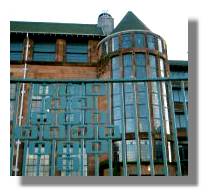 Mackintosh's creativity starts at the front gate - stonework arches over in a layout reminiscent of a castle gate (see the illustration at the top of this page) and instead of the standard vertical railings, the metalwork has references to the characteristic Mackintosh squares which were being used in Miss Cranston's Tea Room in Sauchiehall Street (which he was completing at the time of Scotland Street School). Except that they are not quite square and are intended to represent seeds of a thistle - symbolising the growth of the Scottish children who passed through the school.
Mackintosh's creativity starts at the front gate - stonework arches over in a layout reminiscent of a castle gate (see the illustration at the top of this page) and instead of the standard vertical railings, the metalwork has references to the characteristic Mackintosh squares which were being used in Miss Cranston's Tea Room in Sauchiehall Street (which he was completing at the time of Scotland Street School). Except that they are not quite square and are intended to represent seeds of a thistle - symbolising the growth of the Scottish children who passed through the school.
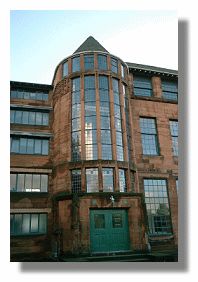 Mackintosh was given the standard School Board symetrical layout, with a separate entrance for boys and girls. However, instead of a boring, plain building, Mackintosh created above each entrance a soaring, traditional Scottish tower. But instead of solid stone with small windows he turned the concept on its head and made the towers almost all in glass - with Mackintosh design embellishments. The stonework at the top of the towers has some inspired Mackintosh mouldings which give life to the move from wall to windows. And on the roof, the tracery of the covers to the chimneys is another piece of Mackintosh whimsy.
Mackintosh was given the standard School Board symetrical layout, with a separate entrance for boys and girls. However, instead of a boring, plain building, Mackintosh created above each entrance a soaring, traditional Scottish tower. But instead of solid stone with small windows he turned the concept on its head and made the towers almost all in glass - with Mackintosh design embellishments. The stonework at the top of the towers has some inspired Mackintosh mouldings which give life to the move from wall to windows. And on the roof, the tracery of the covers to the chimneys is another piece of Mackintosh whimsy.
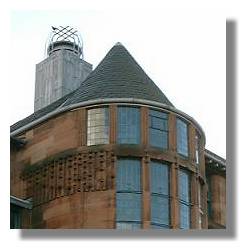
The public entrance to the school now uses the former infant's door (which Mackintosh had made charmingly smaller for the five-year-olds). In the recent refurbishment of the school, a hi-tech, visitor operated door has been installed, at vast expense. The instructions on the door say - press the green button. The only problem is the button is a few feet behind, invisible to anyone reading the notice!
The Rear of the Building
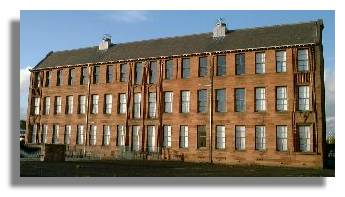
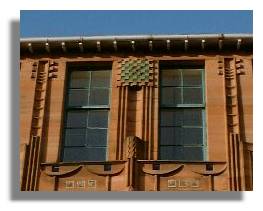 After the imposing features of the towers and architectural features at the front of the building, the rear view looks almost like an old-fashioned, standard school format. At a distance, the three storeys of classrooms and evenly spaced out windows on a flat facade look straight-forward. But as soon as you move closer, the Mackintosh designs start to appear. In the centre, near the roof, is a stylised thistle and "tree of life" motif made up of squares and triangles.
After the imposing features of the towers and architectural features at the front of the building, the rear view looks almost like an old-fashioned, standard school format. At a distance, the three storeys of classrooms and evenly spaced out windows on a flat facade look straight-forward. But as soon as you move closer, the Mackintosh designs start to appear. In the centre, near the roof, is a stylised thistle and "tree of life" motif made up of squares and triangles.
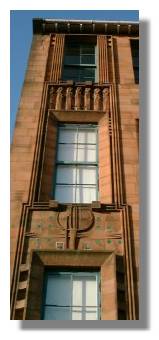 At each end of the building, Mackintosh introduces a series of designs around the windows, leading the eye from one feature to another (see the illustration here). Overall, he manages to create the effect of a classical centre-piece and wings.
At each end of the building, Mackintosh introduces a series of designs around the windows, leading the eye from one feature to another (see the illustration here). Overall, he manages to create the effect of a classical centre-piece and wings.
In typical fashion, the children's playground at the rear is divided by an iron railing - totally separating the boys and the girls. At the back of the playground is a covered, sheltered area - no doubt very welcome in a dark, wet, Glasgow winter! At one stage, there was even a a set of swings and a roundabout - now no longer there.
Inside the School
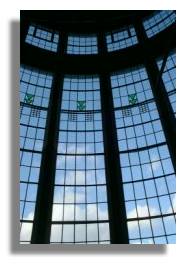 The School Board's design is more apparent inside the building, with classrooms, corridors and cloak-rooms in a standard layout. But Mackintosh manages to introduce interest by first of all lowering the main hall from the corridor and classrooms at the back. And, of course, there are those soaring towers, seen from the inside. Although there are standard straight flights of stairs, instead of a spiral one, they look out onto semi-circular light wells. The Mackintosh squares and triangles shine through onto the stair. And the children walking up and down the stairs would be able to see the "outside world".
The School Board's design is more apparent inside the building, with classrooms, corridors and cloak-rooms in a standard layout. But Mackintosh manages to introduce interest by first of all lowering the main hall from the corridor and classrooms at the back. And, of course, there are those soaring towers, seen from the inside. Although there are standard straight flights of stairs, instead of a spiral one, they look out onto semi-circular light wells. The Mackintosh squares and triangles shine through onto the stair. And the children walking up and down the stairs would be able to see the "outside world".
But the School Board's tight purse meant that internally there was little cash available for Mackintosh to let his genius for design any freedom. He fought with the Board for ornamentation on the glazed tiles - and lost.
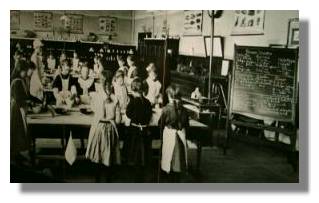 While some of the classrooms have been appropriately given over to displaying art work from the students of the Glasgow School of Art (one of Mackintosh's finest buildings) some have been restored to have the look and feel of classrooms in the 20th century - with rigid ranks of wooden desks, ink wells, blackboard and appropriate educational posters on the wall. A nice touch in the restoration has been to display on the landings of the stairs, pictures taken in the school in its early days. The cookery class, in particular (no boys in that class in those days) is particularly evocative.
While some of the classrooms have been appropriately given over to displaying art work from the students of the Glasgow School of Art (one of Mackintosh's finest buildings) some have been restored to have the look and feel of classrooms in the 20th century - with rigid ranks of wooden desks, ink wells, blackboard and appropriate educational posters on the wall. A nice touch in the restoration has been to display on the landings of the stairs, pictures taken in the school in its early days. The cookery class, in particular (no boys in that class in those days) is particularly evocative.
Conclusion
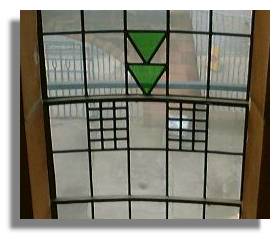 I am told that many of the children who passed through the school gates were told by the staff about the architectural features and about Charles Rennie Mackintosh. There cannot be many state schools with such a pedigree! I am sure they must have appreciated the layout and the design - climbing those stairs, particularly in a dark winter day, when it was a well of light, must have been a magical experience for the young children. Certainly, although the school closed several decades ago, many former pupils have fond memories of the place. Many return as adults to renew their memories of the place.
I am told that many of the children who passed through the school gates were told by the staff about the architectural features and about Charles Rennie Mackintosh. There cannot be many state schools with such a pedigree! I am sure they must have appreciated the layout and the design - climbing those stairs, particularly in a dark winter day, when it was a well of light, must have been a magical experience for the young children. Certainly, although the school closed several decades ago, many former pupils have fond memories of the place. Many return as adults to renew their memories of the place.
Although located south of the river Clyde (on Scotland Street, of course) and therefore away from the city centre, Scotland Street School is easily accessed via the Glasgow Underground - Shields Road station is just across the road from the school.
Access to Scotland Street School is free - and as can be seen from the large number of illustrations in this feature, photography is permitted (a rare opportunity in the interior of Mackintosh buildings!). There is also a small cafeteria and souvenir shop.



